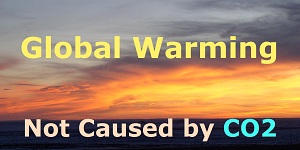|
|
Gary Novak Independent Scientist Global Warming: Home Crunching the Numbers Absorption Spectra Explanations Oceans not Rising Future Ice Age Acid in the Oceans Context News, Opinions, More The Cause of Ice Ages and Present Climate
|
The Non-Debunking of Heinz Hug's Measurement
Fakes pretend to have debunked Heinz Hug's publication, and they spread their claims whimsically across the internet; so I can't avoid saying something about it. The first thing honest persons should notice is the difference between real information and the triteness of the fakes. Fakes never explain anything. When a few reasons are stated, they are short brush-offs rather than anything that can be checked out. Heinz Hug measured the absorption spectrum of CO2 and then doubled the amount of CO2 to show what an increase does. He said only 0.17% of the spectrum can trap additional radiation, which does not allow the huge numbers used by the IPCC. He showed that the bandwidth does not increase with doubling of CO2. Only the smallest edge of the shoulders on the absorption graph can avoid saturation with an increase. Yet one of the claims of alarmists is that increases in CO2 widen the bandwidth, as shown by a fake graph which they use. From my perspective, there was no reason to even conduct a measurement, beyond showing the important fact that most of the radiation gets absorbed in 10 meters. Any point that is picked on the absorption curve will result in the same amount of radiation being absorbed in half the distance upon doubling of the CO2. Is half the distance an increase in temperature when the original distance is one kilometer? No one can say what the temperature increase will be and where, but it's obvious that reducing the distance is not significant at any point on the curve. Near the center of the absorption peak the distance is about 10 meters. Reducing such a short distance to half does nothing of relevance, since circulation of air mixes it all together. Out on the shoulders, where there are one tenth as many molecules, the distance is reduced from 100 meters to 50 meters upon doubling the CO2. Still no relevance. Where the density of CO2 is on hundredth that of the peak, the distance is one kilometer before doubling and one half kilometer after doubling. You might think there starts to be some relevance in reducing the distance from one kilometer to one half kilometer, but this pertains to miniscule amounts of heat being spread over a half kilometer of distance. So the only real question is, how miniscule are these quantities. I take up these questions on the page titled Crunching the Numbers. The debunkers claim Hug's study is just rubbish. Their primary argument is that he did not account for height in the atmosphere, where atmospheric pressure gets lower and water vapor decreases. Guess what. Both of those factors make the shoulders on the absorption peaks narrower. But it is not relevant, because Hug never attempted to evaluate everything in climatology. All he showed was how small the shoulders were. In other words, the debunkers made nonsensical statements. Of course, Hug could not account for everything that occurs in the atmosphere; but neither can anyone else. And from my view, none of it is relevant, because reducing the distance of absorption is never quantitatively relevant.
|
|||||
 | ||||||


